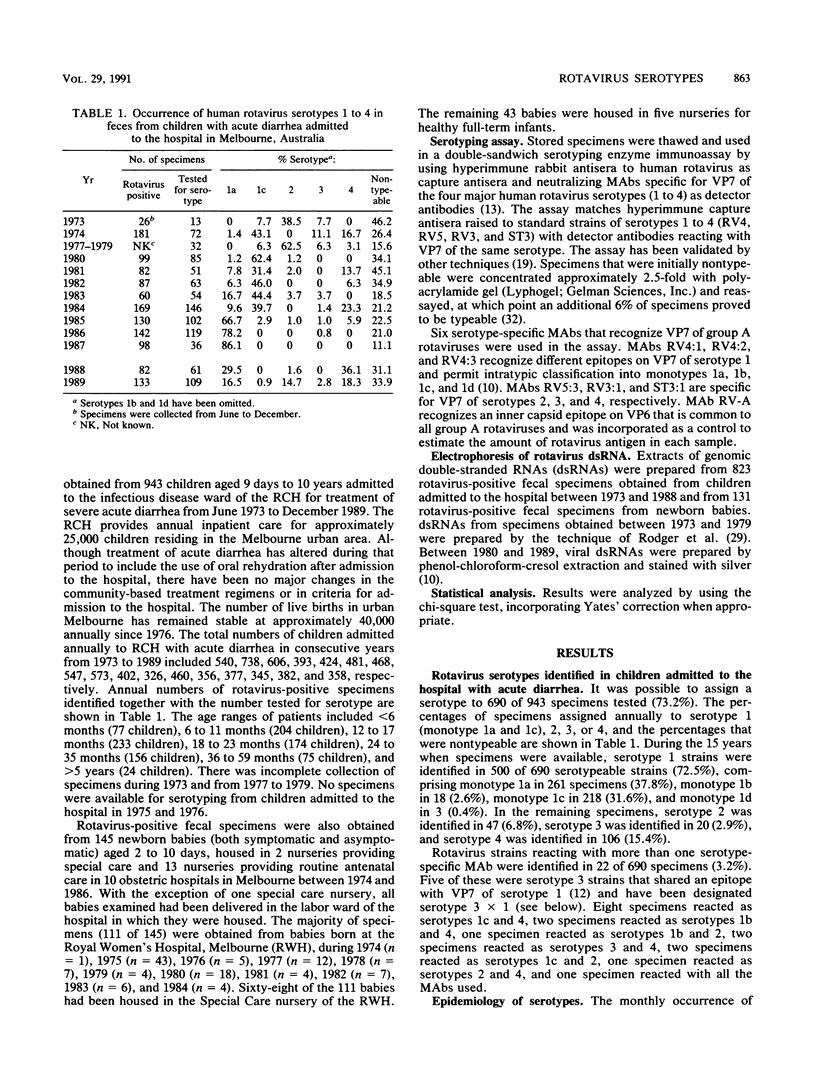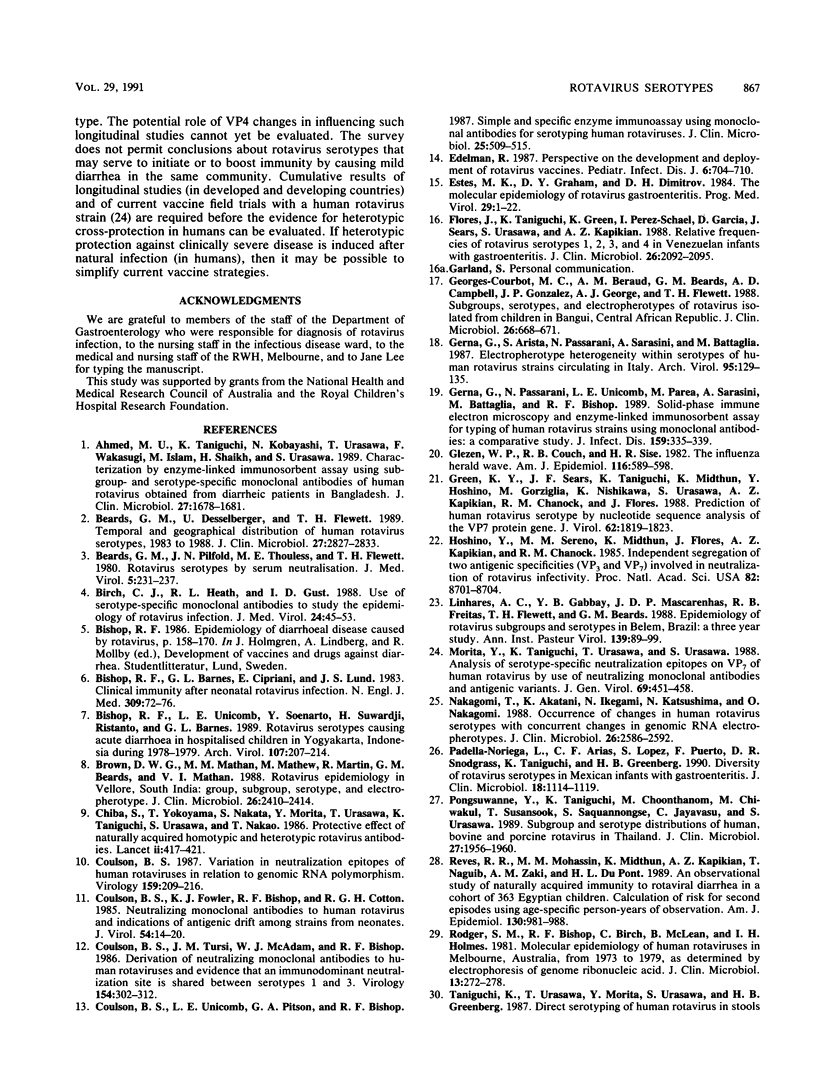Abstract
Fecal rotavirus strains collected between 1973 and 1989 from 943 children admitted with acute diarrhea to one hospital in Melbourne, Australia, were serotyped by using an enzyme-linked immunosorbent assay. The assay incorporated neutralizing monoclonal antibodies specific for VP7 of the four major human serotypes (1 through 4). A serotype could be assigned to 690 of 943 specimens (73.2%). Typeable strains comprised serotype 1 (72.5%), serotype 2 (6.8%), serotype 3 (2.9%), or serotype 4 (15.4%). Monotypes 1a and 1c comprised 52 and 44%, respectively, of serotype 1 strains. All serotypes and monotypes exhibited polymorphic genomic RNAs. Specimens reacting as mixed serotypes were rare (3.2%) and included intertypic strains (0.7%) and mixed infections (1.0%). Nontypeable strains for which an electropherotype could be determined appeared to be identical with typeable strains present concurrently in the community. Serotypes exhibited various epidemiological patterns. Serotype 1 strains were dominant except during three successive winters when 60 to 90% of the disease was caused by serotype 2. Serotype 4 strains showed an episodic pattern of appearance, recurring at peak incidence approximately every 3 years. Fecal rotavirus strains collected from 145 newborn babies housed in Melbourne obstetric hospitals between 1974 and 1986 were also serotyped. All 135 typeable strains (93.1%) belonged to serotype 3. It is hypothesized that endemic infection with serotype 3 rotaviruses in nurseries for the newborn influenced the epidemiology of rotavirus serotypes responsible for severe clinical disease in young children in the same community.
Full text
PDF






Selected References
These references are in PubMed. This may not be the complete list of references from this article.
- Ahmed M. U., Taniguchi K., Kobayashi N., Urasawa T., Wakasugi F., Islam M., Shaikh H., Urasawa S. Characterization by enzyme-linked immunosorbent assay using subgroup- and serotype-specific monoclonal antibodies of human rotavirus obtained from diarrheic patients in Bangladesh. J Clin Microbiol. 1989 Jul;27(7):1678–1681. doi: 10.1128/jcm.27.7.1678-1681.1989. [DOI] [PMC free article] [PubMed] [Google Scholar]
- Beards G. M., Desselberger U., Flewett T. H. Temporal and geographical distributions of human rotavirus serotypes, 1983 to 1988. J Clin Microbiol. 1989 Dec;27(12):2827–2833. doi: 10.1128/jcm.27.12.2827-2833.1989. [DOI] [PMC free article] [PubMed] [Google Scholar]
- Beards G. M., Pilfold J. N., Thouless M. E., Flewett T. H. Rotavirus serotypes by serum neutralisation. J Med Virol. 1980;5(3):231–237. doi: 10.1002/jmv.1890050307. [DOI] [PubMed] [Google Scholar]
- Birch C. J., Heath R. L., Gust I. D. Use of serotype-specific monoclonal antibodies to study the epidemiology of rotavirus infection. J Med Virol. 1988 Jan;24(1):45–53. doi: 10.1002/jmv.1890240107. [DOI] [PubMed] [Google Scholar]
- Bishop R. F., Barnes G. L., Cipriani E., Lund J. S. Clinical immunity after neonatal rotavirus infection. A prospective longitudinal study in young children. N Engl J Med. 1983 Jul 14;309(2):72–76. doi: 10.1056/NEJM198307143090203. [DOI] [PubMed] [Google Scholar]
- Bishop R. F., Unicomb L. E., Soenarto Y., Suwardji H., Ristanto, Barnes G. L. Rotavirus serotypes causing acute diarrhoea in hospitalized children in Yogyakarta, Indonesia during 1978-1979. Arch Virol. 1989;107(3-4):207–213. doi: 10.1007/BF01317917. [DOI] [PubMed] [Google Scholar]
- Brown D. W., Mathan M. M., Mathew M., Martin R., Beards G. M., Mathan V. I. Rotavirus epidemiology in Vellore, south India: group, subgroup, serotype, and electrophoretype. J Clin Microbiol. 1988 Nov;26(11):2410–2414. doi: 10.1128/jcm.26.11.2410-2414.1988. [DOI] [PMC free article] [PubMed] [Google Scholar]
- Chiba S., Yokoyama T., Nakata S., Morita Y., Urasawa T., Taniguchi K., Urasawa S., Nakao T. Protective effect of naturally acquired homotypic and heterotypic rotavirus antibodies. Lancet. 1986 Aug 23;2(8504):417–421. doi: 10.1016/s0140-6736(86)92133-1. [DOI] [PubMed] [Google Scholar]
- Coulson B. S., Fowler K. J., Bishop R. F., Cotton R. G. Neutralizing monoclonal antibodies to human rotavirus and indications of antigenic drift among strains from neonates. J Virol. 1985 Apr;54(1):14–20. doi: 10.1128/jvi.54.1.14-20.1985. [DOI] [PMC free article] [PubMed] [Google Scholar]
- Coulson B. S., Tursi J. M., McAdam W. J., Bishop R. F. Derivation of neutralizing monoclonal antibodies to human rotaviruses and evidence that an immunodominant neutralization site is shared between serotypes 1 and 3. Virology. 1986 Oct 30;154(2):302–312. doi: 10.1016/0042-6822(86)90456-3. [DOI] [PubMed] [Google Scholar]
- Coulson B. S., Unicomb L. E., Pitson G. A., Bishop R. F. Simple and specific enzyme immunoassay using monoclonal antibodies for serotyping human rotaviruses. J Clin Microbiol. 1987 Mar;25(3):509–515. doi: 10.1128/jcm.25.3.509-515.1987. [DOI] [PMC free article] [PubMed] [Google Scholar]
- Coulson B. S. Variation in neutralization epitopes of human rotaviruses in relation to genomic RNA polymorphism. Virology. 1987 Aug;159(2):209–216. doi: 10.1016/0042-6822(87)90457-0. [DOI] [PubMed] [Google Scholar]
- Edelman R. Perspective on the development and deployment of rotavirus vaccines. Pediatr Infect Dis J. 1987 Aug;6(8):704–710. doi: 10.1097/00006454-198708000-00002. [DOI] [PubMed] [Google Scholar]
- Estes M. K., Graham D. Y., Dimitrov D. H. The molecular epidemiology of rotavirus gastroenteritis. Prog Med Virol. 1984;29:1–22. [PubMed] [Google Scholar]
- Flores J., Taniguchi K., Green K., Perez-Schael I., Garcia D., Sears J., Urasawa S., Kapikian A. Z. Relative frequencies of rotavirus serotypes 1, 2, 3, and 4 in Venezuelan infants with gastroenteritis. J Clin Microbiol. 1988 Oct;26(10):2092–2095. doi: 10.1128/jcm.26.10.2092-2095.1988. [DOI] [PMC free article] [PubMed] [Google Scholar]
- Georges-Courbot M. C., Beraud A. M., Beards G. M., Campbell A. D., Gonzalez J. P., Georges A. J., Flewett T. H. Subgroups, serotypes, and electrophoretypes of rotavirus isolated from children in Bangui, Central African Republic. J Clin Microbiol. 1988 Apr;26(4):668–671. doi: 10.1128/jcm.26.4.668-671.1988. [DOI] [PMC free article] [PubMed] [Google Scholar]
- Gerna G., Arista S., Passarani N., Sarasini A., Battaglia M. Electropherotype heterogeneity within serotypes of human rotavirus strains circulating in Italy. Brief report. Arch Virol. 1987;95(1-2):129–135. doi: 10.1007/BF01311340. [DOI] [PubMed] [Google Scholar]
- Gerna G., Passarani N., Uricomb L. E., Parea M., Sarasini A., Battaglia M., Bishop R. F. Solid-phase immune electron microscopy and enzyme-linked immunosorbent assay for typing of human rotavirus strains by using polyclonal and monoclonal antibodies: a comparative study. J Infect Dis. 1989 Feb;159(2):335–339. doi: 10.1093/infdis/159.2.335. [DOI] [PubMed] [Google Scholar]
- Glezen W. P., Couch R. B., Six H. R. The influenza herald wave. Am J Epidemiol. 1982 Oct;116(4):589–598. doi: 10.1093/oxfordjournals.aje.a113441. [DOI] [PubMed] [Google Scholar]
- Green K. Y., Sears J. F., Taniguchi K., Midthun K., Hoshino Y., Gorziglia M., Nishikawa K., Urasawa S., Kapikian A. Z., Chanock R. M. Prediction of human rotavirus serotype by nucleotide sequence analysis of the VP7 protein gene. J Virol. 1988 May;62(5):1819–1823. doi: 10.1128/jvi.62.5.1819-1823.1988. [DOI] [PMC free article] [PubMed] [Google Scholar]
- Hoshino Y., Sereno M. M., Midthun K., Flores J., Kapikian A. Z., Chanock R. M. Independent segregation of two antigenic specificities (VP3 and VP7) involved in neutralization of rotavirus infectivity. Proc Natl Acad Sci U S A. 1985 Dec;82(24):8701–8704. doi: 10.1073/pnas.82.24.8701. [DOI] [PMC free article] [PubMed] [Google Scholar]
- Linhares A. C., Gabbay Y. B., Mascarenhas J. D., Freitas R. B., Flewett T. H., Beards G. M. Epidemiology of rotavirus subgroups and serotypes in Belem, Brazil: a three-year study. Ann Inst Pasteur Virol. 1988 Jan-Mar;139(1):89–99. doi: 10.1016/s0769-2617(88)80009-1. [DOI] [PubMed] [Google Scholar]
- Morita Y., Taniguchi K., Urasawa T., Urasawa S. Analysis of serotype-specific neutralization epitopes on VP7 of human rotavirus by the use of neutralizing monoclonal antibodies and antigenic variants. J Gen Virol. 1988 Feb;69(Pt 2):451–458. doi: 10.1099/0022-1317-69-2-451. [DOI] [PubMed] [Google Scholar]
- Nakagomi T., Akatani K., Ikegami N., Katsushima N., Nakagomi O. Occurrence of changes in human rotavirus serotypes with concurrent changes in genomic RNA electropherotypes. J Clin Microbiol. 1988 Dec;26(12):2586–2592. doi: 10.1128/jcm.26.12.2586-2592.1988. [DOI] [PMC free article] [PubMed] [Google Scholar]
- Padilla-Noriega L., Arias C. F., López S., Puerto F., Snodgrass D. R., Taniguchi K., Greenberg H. B. Diversity of rotavirus serotypes in Mexican infants with gastroenteritis. J Clin Microbiol. 1990 Jun;28(6):1114–1119. doi: 10.1128/jcm.28.6.1114-1119.1990. [DOI] [PMC free article] [PubMed] [Google Scholar]
- Pongsuwanne Y., Taniguchi K., Choonthanom M., Chiwakul M., Susansook T., Saguanwongse S., Jayavasu C., Urasawa S. Subgroup and serotype distributions of human, bovine, and porcine rotavirus in Thailand. J Clin Microbiol. 1989 Sep;27(9):1956–1960. doi: 10.1128/jcm.27.9.1956-1960.1989. [DOI] [PMC free article] [PubMed] [Google Scholar]
- Reves R. R., Hossain M. M., Midthun K., Kapikian A. Z., Naguib T., Zaki A. M., DuPont H. L. An observational study of naturally acquired immunity to rotaviral diarrhea in a cohort of 363 Egyptian children. Calculation of risk for second episodes using age-specific person-years of observation. Am J Epidemiol. 1989 Nov;130(5):981–988. doi: 10.1093/oxfordjournals.aje.a115431. [DOI] [PubMed] [Google Scholar]
- Rodger S. M., Bishop R. F., Birch C., McLean B., Holmes I. H. Molecular epidemiology of human rotaviruses in Melbourne, Australia, from 1973 to 1979, as determined by electrophoresis of genome ribonucleic acid. J Clin Microbiol. 1981 Feb;13(2):272–278. doi: 10.1128/jcm.13.2.272-278.1981. [DOI] [PMC free article] [PubMed] [Google Scholar]
- Unicomb L. E., Bishop R. F. Epidemiology of rotavirus strains infecting children throughout Australia during 1986-1987. A study of serotype and RNA electropherotype. Arch Virol. 1989;106(1-2):23–34. doi: 10.1007/BF01311035. [DOI] [PubMed] [Google Scholar]
- Unicomb L. E., Coulson B. S., Bishop R. F. Experience with an enzyme immunoassay for serotyping human group A rotaviruses. J Clin Microbiol. 1989 Mar;27(3):586–588. doi: 10.1128/jcm.27.3.586-588.1989. [DOI] [PMC free article] [PubMed] [Google Scholar]
- Urasawa S., Urasawa T., Taniguchi K., Morita Y., Sakurada N., Saeki Y., Morita O., Hasegawa S. Validity of an enzyme-linked immunosorbent assay with serotype-specific monoclonal antibodies for serotyping human rotavirus in stool specimens. Microbiol Immunol. 1988;32(7):699–708. doi: 10.1111/j.1348-0421.1988.tb01431.x. [DOI] [PubMed] [Google Scholar]
- Urasawa S., Urasawa T., Taniguchi K., Wakasugi F., Kobayashi N., Chiba S., Sakurada N., Morita M., Morita O., Tokieda M. Survey of human rotavirus serotypes in different locales in Japan by enzyme-linked immunosorbent assay with monoclonal antibodies. J Infect Dis. 1989 Jul;160(1):44–51. doi: 10.1093/infdis/160.1.44. [DOI] [PubMed] [Google Scholar]
- Wyatt R. G., James H. D., Jr, Pittman A. L., Hoshino Y., Greenberg H. B., Kalica A. R., Flores J., Kapikian A. Z. Direct isolation in cell culture of human rotaviruses and their characterization into four serotypes. J Clin Microbiol. 1983 Aug;18(2):310–317. doi: 10.1128/jcm.18.2.310-317.1983. [DOI] [PMC free article] [PubMed] [Google Scholar]


